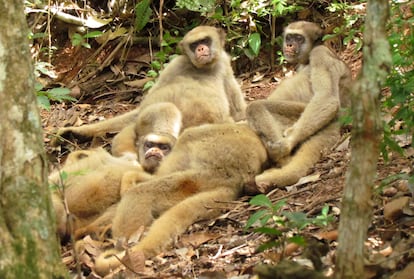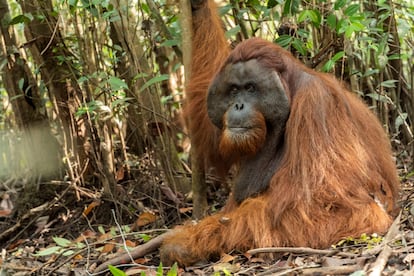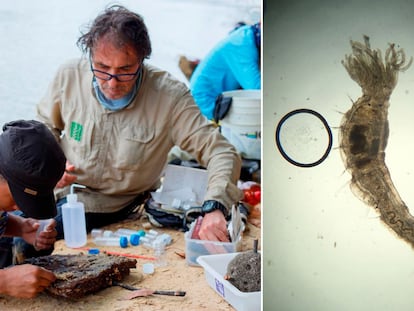Why are the monkeys descending from the trees?
Climate change, deforestation and the extermination of predators are leading arboreal primates to spend more time on the ground

The northern muriqui monkey is born, lives and dies in the trees. These monkeys, once abundant in the dwindling Atlantic Forest of eastern Brazil, eat, socialize, play and reproduce without ever descending to the ground. They only leave their arboreal safety in emergency situations (when a baby falls to the ground, for example) or if they are being chased by a predator. But in the Feliciano Miguel Abdala Private Natural Heritage Reserve, in the state of Minas Gerais, there have been no dangerous predators for a long time. Perhaps this explains why for at least four decades they have been increasingly seen coming down from the trees. At first it was for feeding and little else, but now they spend almost half of their time on the ground, resting and frolicking. This is not an isolated case; it is taking place across the Americas, Africa and Asia.
Primatologists have been studying the Feliciano Miguel Abdala muriquis since the 1970s. This species of spider monkey is on the verge of extinction; there are fewer than 1,000 specimens remaining in the wild and it is classified as “critically endangered” on the International Union for Conservation of Nature’s Red List of Threatened Species. The decline of their natural habitat, the Brazilian Atlantic Forest, has confined them to patches of jungle surrounded by farmland, grazing pastures and forest plots. The upside of so much human pressure is that their natural predators have become extinct; the downside is that their refuge does not surpass 1,000 hectares.
The combination of both factors could explain a phenomenon that began as sporadic but is now a tradition passed down through generations: spending more time on the ground. Scientists first witnessed a muriqui descending from a tree in 1982. They did not see it as hugely significant at the time but they did write it down, as they do with everything they see, either directly or through dozens of cameras installed throughout the forest. With more than 10,000 observations over three years, they estimated 40 years ago that muriquis spent just 0.05% of their time on the ground. In another study conducted between 1998 and 1999, it had increased to 0.7%. In another investigation carried out between 2006 and 2007, with almost 15,000 observations, the percentage had risen to 1%. It doesn’t sound like much, but it represents a twentyfold increase in just a quarter of a century. The data from the most recent campaign is still being analyzed.
The forested margins impose limits to the expansion of the distribution areas, so the only solution was to expand the use of vertical space”Karen Strier, primatóloga de la Universidad Wisconsin-Madison (Estados Unidos)
Karen Strier, a primatologist at the University of Wisconsin-Madison, has been studying the muriquis of the Feliciano Miguel Abdala reserve and other groups still present in the region since 1982. These primates are not only interesting because of their critical situation; being patrilineal and patrilocal, with females coming from outside the group, there is hardly any hierarchy between the sexes and within each gender, which makes it a very egalitarian society, which is rare among primates. For Strier, the increase in visits to the ground is closely related to the rise in demographic pressure in an increasingly reduced space. Time spent on the ground extended, she explains, as the population of muriquis rose to what the scientists suspected could have been a threshold. The forest boundaries of the Feliciano Miguel Abdala reserve impose limits on the expansion of the distribution areas, so the only solution was to make the most out of the vertical space. This is what muriquis, as well as other arboreal primates, are being forced to do.
But the quality of the time spent on the ground is just as relevant as the amount. During the course of their observations, scientists have noticed a series of changes that point to the institutionalization of the new practice. The descents, previously reserved for emergencies, became more frequent: first to feed, but later also to move between the increasingly larger clearings. Today, more than a third of the time the muriquis spend in the shade of the trees is used for socializing, or even simply resting. This would imply, as Strier and her colleagues write, that the current patterns of the muriquis’ land use show more than just a response to an ecological need. On many occasions they were seen descending to the ground to go to another tree, even when there were viable alternatives to move from branch to branch. For the scientists, the fact that these monkeys have extended that facet to non-essential activities implies that their aversion to terrestrial dangers has relaxed. And that aversion is carried in the genes.
Far away from Brazil, in southern Ethiopia, lives the Bale Mountain vervet. Like mandrills or baboons, it belongs to the cercopithecidae family, which is also known as the Old World monkey family. Their ancestors were the first primates to descend from the trees, before the hominids did. The vervet is one of the few species in the family that is 100% arboreal - or at least it used to be. This monkey is doubly unique. In addition to being the only arboreal monkey of its genus, it is the only one of the six species of the group that bases its diet on practically one thing: leaves and tender stems of bamboo. As in the Brazilian jungle, human advance in the Ethiopian plateaus has fragmented the forest, which is now surrounded by land for farming and livestock.
In a study published in 2018, researchers from the universities of Addis Ababa (Ethiopia) and Oslo (Norway) followed four populations of vervets: two that lived in one of the few still-intact bamboo forests and two that survived in highly fragmented and deteriorated plots of forest. They saw that the former still had a diet that was 80% made up of bamboo, while the latter had had to diversify it to include insects and vegetables that they stole from human crops. But they noticed something else. Primatologist Addisu Mekonnen Kassie shared the numbers: the vervet monkeys living in the fragmented forest spent much more time on the ground (36.5%) than those in the continuous forest (2.3%). Again, habitat deterioration appears as the trigger of a new behavior.

Adapting to a changing landscape
Even further away from Brazil, in the Tuanan forest on the island of Borneo (Indonesia), several groups of orangutans have been studied for decades. They are not monkeys; like humans, they are great apes. The orangutan is the largest arboreal mammal on the planet, and contrary to what was believed until recently, it also descends to the ground. Monitoring since the turn of the century has confirmed that one of the Tuanan groups spends an average of 2.29% of its time there. The percentage rises to 5% in the case of adult males. This male audacity is a constant in all species of arboreal monkeys that are adopting terrestrial habits. Compared to other populations in areas where deforestation has caused a lot of damage, they found that orangutans here spend twice as much time on the ground.
The other orangutan species lives on the neighboring island of Sumatra, but they do not touch the ground there. The reason could be the tiger: the great predator of Southeast Asia is extinct in Borneo, wiped out by humans centuries ago. However, these felines are still present in Sumatra, and their habitat overlaps with that of the great apes.
The PNAS scientific journal recently published a review of the terrestriality in almost 50 species of primates of the Americas and Madagascar. The investigation, in which more than a hundred primatologists participated, shows that the descent of arboreal primates to the ground is still relatively short-lived; the average time they devote to their ground activities is 2.5%. The study also points out some of the factors that are influencing the arboreal behavior of these animals. Three among them are being subjected to such quick rate of change that they transcend the pace of nature: habitat degradation (especially deforestation), the elimination of natural predators and, finally, climatic conditions.
"With the accelerating effects of climate change and deforestation, we predict that some of these species will descend to the ground more frequently to survive in these changing landscapes."Tim Eppley, biólogo de la San Diego Zoo Wildlife Alliance
Tim Eppley, a biologist at the San Diego Zoo Wildlife Alliance, is the lead author of this huge piece of research. He explains that the main goal of the study was to understand what drives an arboreal species to spend more time on the ground. Many recent reports have shown that certain species are spending time on the ground, something rarely seen before, so the scientists wanted to find out if those species shared a specific trait, or if there were certain anthropogenic or ecological pressures that could explain it. Their work concludes that higher temperatures and decreases in canopy cover increase the use of land by these primate species. With the accelerating effects of climate change and deforestation, they predict that some of these species will descend to the ground more often in order to survive in changing landscapes.
Climate change, like the one currently underway, created the conditions and the selective pressure that drove our ancestors to descend from the trees. However, comparing then and now would be, say experts on human evolution, absurd. Salvador Moyà, a researcher at the Institut Català de Paleontologia Miquel Crusafont in Barcelona, explains: “About 14 million years ago, forests reached northern Germany, but the climate changed, becoming warmer and drier. The forests shrank and concentrated towards the equator. This caused new selective pressures that favored a new model of life, terrestrial life.” Moyà insists that two basic ingredients are necessary in order for there to be evolution: “On one hand, selective pressures that favor a new type of organism, that the negative versions are negatively selected and those that adapt to the environment survive. On the other hand, there must be candidates with a morphology that helps them be positively selected.”
A selective pressure exists now, but there are two different components. Moyà elaborates: “The current change is happening at supersonic speed, from seven million years ago to the current rate there is an abyss. In addition, there must be good pre-adapted candidates who could take advantage of the new conditions. A group of primates that adapts to the ground could appear: the Papionini [mandrills, baboons] did it 15 million years ago and we did it six million years ago. There are two possibilities, that they adapt to a more terrestrial way of life or that they simply become extinct. Most likely, being such an instantaneous change, it will end in a catastrophic event.”
Tim White is the director of the Human Evolution Research Center at the University of California, Berkeley. He discovered Ardipithecus ramidus, a candidate to be one of the first hominids that descended from the trees, and he rejects any type of similarity between the past and the present situation. He explains that the habitats available to early hominids in Africa were varied and included open and closed settings, and all of them show evolutionary adaptations to bipedalism, as opposed to the behavioral changes documented in this research. There were monkeys and apes that lived at the same time as these early hominids, and none of them became bipedal. For him, there was evolution then, while now there is an adjustment of behavior.
What White, Moyà and Eppley agree on is that the rate of deforestation and climate change are such that there will be no time for adaptation to arise for some individuals who know how to take advantage of the new conditions, as our ancestors did millions of years ago.
Tu suscripción se está usando en otro dispositivo
¿Quieres añadir otro usuario a tu suscripción?
Si continúas leyendo en este dispositivo, no se podrá leer en el otro.
FlechaTu suscripción se está usando en otro dispositivo y solo puedes acceder a EL PAÍS desde un dispositivo a la vez.
Si quieres compartir tu cuenta, cambia tu suscripción a la modalidad Premium, así podrás añadir otro usuario. Cada uno accederá con su propia cuenta de email, lo que os permitirá personalizar vuestra experiencia en EL PAÍS.
¿Tienes una suscripción de empresa? Accede aquí para contratar más cuentas.
En el caso de no saber quién está usando tu cuenta, te recomendamos cambiar tu contraseña aquí.
Si decides continuar compartiendo tu cuenta, este mensaje se mostrará en tu dispositivo y en el de la otra persona que está usando tu cuenta de forma indefinida, afectando a tu experiencia de lectura. Puedes consultar aquí los términos y condiciones de la suscripción digital.
More information
Archived In
Últimas noticias
Most viewed
- Alain Aspect, Nobel laureate in physics: ‘Einstein was so smart that he would have had to recognize quantum entanglement’
- Mexico’s missing people crisis casts a shadow over World Cup venue
- Why oil has been at the center of Venezuela-US conflicts for decades
- Trump clarifies who is ultimately in charge in Venezuela: ‘Me’
- Mexico seeks to shore up its defenses following US incursion in Venezuela










































